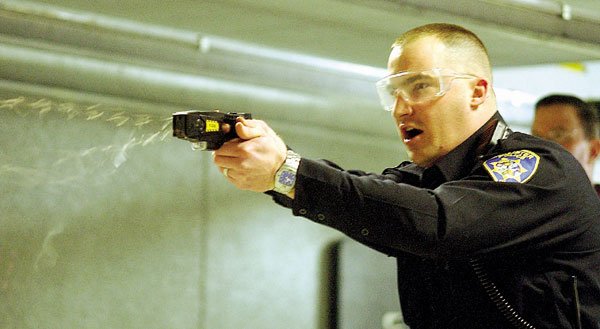Being a cop means responding to last-minute calls and having to
deal with people most would consider a little ‘off.’ Every shift
means being prepared for the unexpected and unusual
You never know how a shift is going to go from one minute to the next. With a 12-hour week-night shift before him, officer Dave Anderson of the Hollister Police Department started his evening with some of the usual stuff.
He had a briefing, checked his work e-mail, drove past all the local bars to monitor the scenes and responded to a call for vandalism.
He stopped a bicyclist riding without any lights. He politely but firmly asked the man if he minded being patted down before chatting with him about road safety. After checking to see if the man had any warrants out for his arrest, Anderson let him go with a warning.
The officer then did a full initial sweep of his beat in his car and was just settling in to make some traffic stops when a call came over the radio.
It was around 9:30pm, and the dispatcher could only provide sketchy details about someone finding a person in their garage who wouldn’t leave. The garage wasn’t on Anderson’s beat, but the officer who should have responded was busy with another call. So, Anderson, 34, turned his car around and headed for the call that, unbeknownst to him, was going to make his usual Wednesday night take a turn for the unusual.
Because 911 calls dictate whether police officers have a mundane shift or an action-packed shift, cops need to be prepared for anything.
The people in the house who called the police explained a young girl had been living out of their garage for about a week. She had been a casual acquaintance of one member of their family, but no one knew much about her. The girl claimed to be 19, but she gave them a birth date that would put her in her 30s.
The family asked if she worked, and the girl said yes. The family didn’t want her there, but they were reluctant to kick her out onto the streets. The final straw came when someone noticed self-inflicted cut marks on the girl’s arm. They finally called the police.
Anderson listened to the family explain the situation, asked a few questions and headed out to the garage at the rear of the house.
He offered a perfunctory knock before opening the door. The girl was perched on a pile of clothes and blankets, and she met his gaze evenly.
“Hi, I’m officer Anderson. Could you step outside, please?” he asked the girl.
Nodding, she silently followed him out to the side of the garage. She was neat and clean, wearing baggy black pants and a sweatshirt that was about three times too big for her. She was visibly nervous and fidgety.
Anderson patted the girl down, took a pocket knife from her and had her sit on the patio. He began asking her questions, which she seemed to answer honestly.
She was 15 years old, she had run away from home and dropped out of school. Anderson asked about her cutting herself, which she denied, and a quick glance at her arms seemed to support her answer.
As Anderson started radioing in her information, the girl began to get even more fidgety.
“Can I make a phone call? I just need to go inside and use the phone,” she said, and started to get up.
Anderson stopped talking into his radio long enough to put a hand on her shoulder.
“You need to sit still and stay put for a minute,” he said before going back to talking with the dispatch center on his radio. He was trying to locate the girl’s parents. The girl started to get up again.
“I’m going to go inside real quick and use the phone,” she said.
“You don’t need to use the phone. You need to sit right here until I tell you to get up,” Anderson told her, catching her arm and directing her back to the ground.
Again the girl tried to get up, only this time she started cursing about the flashlight being in her eyes. She continued trying to tell Anderson she needed to use the phone.
“Listen, you need to sit where I tell you to sit. If you try to get up again or try to go anywhere, I’m going to have to taser you, which is going to hurt. I don’t want to hurt you, and I don’t want to chase you. So sit still until I tell you it’s OK to get up. Do you understand me?” Anderson said, irritation finally creeping into his voice.
After a half-hour or so, the girl’s parents were finally located. It appeared they had moved out of town since the girl ran away, and it was going to take them a while to get back to Hollister. Anderson talked with two other officers who had come to make sure the situation was under control. They were trying to decide the best place to take the girl while they waited for her parents.
The girl finally began to cry in deep, gulping sobs. Anderson led her to his car and put her in the back seat. As an afterthought he double-checked the girl’s arms, and the situation became even more complicated. There, on her arm, were several angry red cut marks. They had been under a shadow the first time Anderson looked, but this time he shined his light right on them.
“When did you do this? Did you use that pocket knife I took to do this? How often do you hurt yourself? Do you ever think about killing yourself? Why would you want to do that?” Anderson asked, using a softer voice.
“Because it would be easier if I wasn’t here. It would be better,” she said.
With that, Anderson closed her car door and drove to Hazel Hawkins Memorial Hospital. All the way there, the girl cried.
At the hospital, Anderson was required to fill out a stack of paperwork. The hospital was so busy that the girl couldn’t be admitted right away, and Anderson stayed with her. More confusion had arisen about exactly where the girl’s parents were, when they were going arrive and whether Child Protective Services should be involved.
Other calls that Anderson should be responding to were coming over the radio. He sat in a stiff-backed plastic chair and bounced his right knee up and down in a frustrated gesture. The girl continued to cry but began making rude comments about being in the hospital, about wanting to use the phone and about her parents.
“Look, why am I here? I don’t want to talk to a ****ing counselor. … I don’t want to be here right now,” the girl finally yelled.
With that, Anderson snaps his head in her direction.
“Yeah, well, I don’t give a **** what you want, you’re going to stay here and talk to a counselor and wait for your parents,” he barked at her.
She is shocked into silence.
At last, more than three hours after the initial call, the hospital admitted the girl, and her parents arrived to take over her care. Anderson was free to leave and get back to his beat.
About 15 minutes after leaving the hospital, he has driven past each of the bars in town again, making sure all is calm, and as he prepared to do another sweep of his beat, a call came over the radio. The girl had run away from the hospital, and they needed Anderson to come back and help find her.
As Anderson listened to the call he briefly closed his eyes, as if summoning inner strength. He resigned himself to the fact that he wasn’t going to get away from this call, a call that shouldn’t even have been his in the first place. He returned to the hospital. Such is the life of a Hollister police officer.
Cop Couture: a First-Person Account
When I asked Capt. Bob Brookes of the Hollister Police Department if I could ride along with one of his police officers, he readily agreed, offering me two options.
Option A: I come in “civilian” attire and participate in the ride-along wearing black trousers and a nice sweater and jacket.
Option B: I get the “real cop experience” by wearing a flak jacket under my shirt and a divers belt with about 15 pounds attached to simulate the gun belts officers wear every day with all of their equipment attached.
Of course, I chose option B, if only to brag to friends that I got to wear a bulletproof vest. I was properly warned that it would not be the most comfortable experience, but I assured everyone I could handle it just fine. How wrong I was.
The vest went on over a thin T-shirt and under a heavier sweater. It was designed for a man, and therefore gapped in some places where it should be snug and was too snug in other places where I definitely needed more room. Whenever I sat down, the vest forced me into an unnaturally stiff posture. On top of all that, it was uncomfortably hot under the vest.
The weight of the simulated gun belt forced my trousers down on my hips and rubbed uncomfortably against my lower back. Officers gave me advice on how to tuck my shirt and adjust the belt, but to no avail. It was just plain irritating. I tried to control my body when sitting down, but the extra 15 pounds around my waist forced me into an ungraceful plop. Standing up was like doing squats at the gym – I felt the burn in my thighs after a while.
The combination of the belt and vest made for a very uncool, unflattering and uncomfortable fashion statement. Each time I met someone, I felt as if I should apologize for my appearance. The stiff posture the vest forced me into and the bulky extra weight around my waist made getting in and out of the cop car a joke. I practically had to climb out, using my arms to haul my body up, and getting in was more of a controlled crash landing.
Though I survived the seven-and-a-half hours I spent on the job with officer Dave Anderson wearing the vest, I wussed out on the weight belt after two hours or so. I couldn’t handle it, and my hat is off to all officers who lug all that gear around for 12 hours each shift. I also extend my sincerest thanks to all the officers that saw me in my ridiculous getup and were kind enough not to laugh. I appreciated it.
– By Kelly Savio, Staff Writer
How to Make A 911 Call go Smoothly
– If you see any emergency vehicle on the road with lights flashing and sirens going, immediately pull to the right – not the left – and stop. Even if the vehicle is traveling in the opposite direction, pull to the right to ensure the vehicle has a clear path.
– If you take medications or have an extensive medical history, it’s helpful to write the information down and keep it somewhere accessible. This makes it possible for emergency responders to see at a glance what they may be dealing with, as well as what medications it’s OK to give you.
– If you live alone and have a known health problem, have a good friend or family member call you regularly. That way, if there is ever a time you don’t answer for an extended period of time, someone can call 911 on your behalf and someone will come check on you.
– If you live alone, and especially if you have a known health problem, invest in medical alert devices, such as Life Alert. These devices are often worn around the neck and dial an emergency response center at the touch of a button. These are especially vital when someone has fallen and can’t reach a phone or if their speech has been affected, such as in the case of a stroke.
– If you are alone, having an emergency, able to dial 911 but unable to communicate, dispatchers will automatically send a police unit to your address. However, dispatchers cannot trace cell phone calls to an address. If a police officer shows up at an address, knocks on the door but gets no response, they are apt to leave.
– Be honest with emergency response crews. Lying to paramedics can lead them to misdiagnose a problem, and lying to police can get you into more trouble.
Sources: Officer Dave Anderson, Hollister PD
Capt. Joshua Valverde, Gilroy Fire
Matt Bowdish, Gilroy AMR EMT
Sarah Savage, Morgan Hill 911 dispatcher















